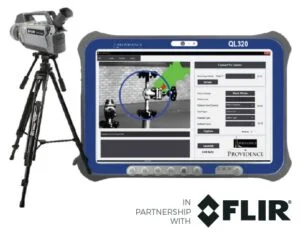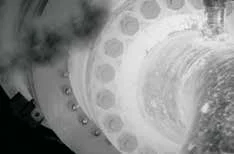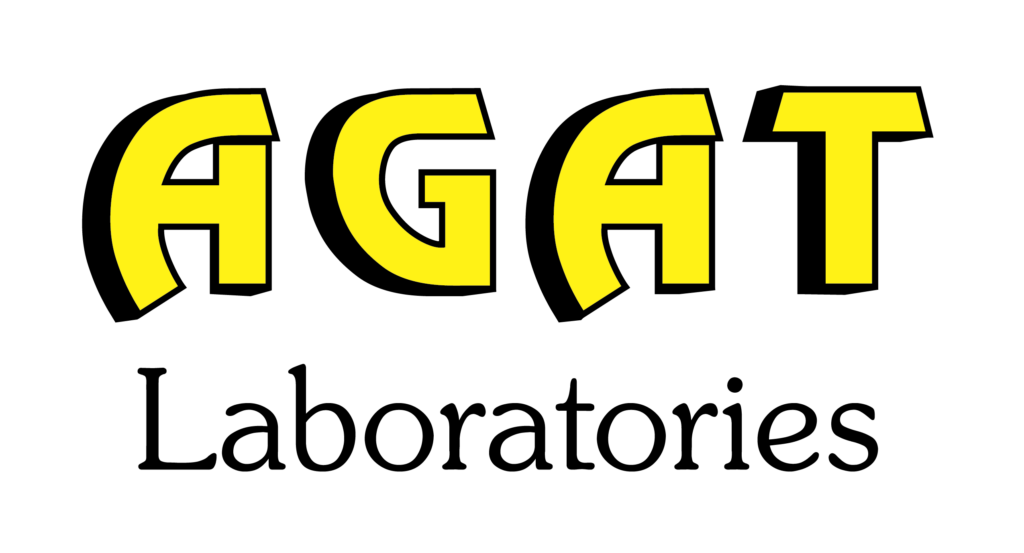ENVIRONNEMENT
Surveillance de la qualité de l'air
Download our Air Quality and
Fugitive Emissions brochures
Surveillance de la qualité de l'air
AGAT Laboratories provides a full range of air services to industries and the government making us a recognized leader throughout Canada. We assist clients in achieving regulatory compliance by evaluating the effectiveness of their air monitoring management systems and providing accurate third party assessments for their environmental impact studies. Our Air Quality Monitoring team has over 40 years of combined experience in providing regulatory technical support and data management services.
We specialize in source emissions testing, continuous ambient air monitoring, passive air monitoring, fugitive emissions testing, integrative monitoring, and multi-sector air pollutants over a range of industry sources including:
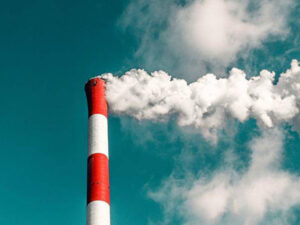 Traitement du pétrole et du gaz
Traitement du pétrole et du gaz- La production d'énergie
- Traitement des pâtes et papiers
- Produits du bois
- Incinérateurs de déchets
- Installations de fabrication
- Zones urbaines
- Test de source non ponctuelle
Assurance qualité et contrôle qualité
Rigorous and comprehensive quality programs are implemented to ensure that data collected is accurate, defensible, representative, and conforms to regulatory guidelines (where applicable).
Our Quality Assurance Program is comprised of the following components:
- Field Technician Training Program involving internal seminars, classroom training, field training and attendance to industry conferences
- In-house database of sampling and monitoring procedures
- Standard Operating Procedures (SOPs) for monitoring, calibration and sampling systems
- Automated daily zero and single-point span calibration, and monthly multi-point calibrations for continuous monitoring stations
- Enhanced data validation services available to maximize precision
- Remote access to continuous monitoring systems
Test des émissions à la source
 AGAT Laboratories Source Testing will provide quality services to assure regulatory compliance for Relative Accuracy Test Audits (RATA), Cylinder Gas Audits (CGA) and Manual Stack Surveys. We maintain industry requirements including CEMS certification and auditing, regulatory emissions compliance, Multi-Sector Air Pollutants Regulations Survey (MSAPR), turbine mapping, process optimization and pollutant control system performance testing.
AGAT Laboratories Source Testing will provide quality services to assure regulatory compliance for Relative Accuracy Test Audits (RATA), Cylinder Gas Audits (CGA) and Manual Stack Surveys. We maintain industry requirements including CEMS certification and auditing, regulatory emissions compliance, Multi-Sector Air Pollutants Regulations Survey (MSAPR), turbine mapping, process optimization and pollutant control system performance testing.
Provincial and Federal Approvals and Codes of Practice may require source emissions testing (also known as stack emissions testing) for many types of pollutants. Our Air Quality Monitoring Division provides emission testing services for several compounds through continuous real-time data (analyzer) and grab sample for analysis.
Notre équipe de test de source dessert les industries suivantes :
- Usines de gaz corrosif
- Raffineries de pétrole
- SAGD et opérations de raffinage d'extraction de sables bitumineux
- Usines OSB
- Installations de pâtes et papiers
- Installations de turbines et de compresseurs
- Centrales électriques au charbon
- Centrales électriques au gaz naturel
- Usines d'asphalte
- Installations de cogénération
- Usines de soufre
- Fabrication de produits chimiques et de produits
Notre division de surveillance de la qualité de l'air fournit des services de test d'émissions pour plusieurs composés, notamment :
*Continuous Analyzer Measurement Capabilities
NOx (Nitrogen Oxides)SO2 (Sulphur Dioxide)TRS (Total Reduced Sulphur)H2S (Hydrogen Sulphide)CO (Carbon Monoxide)O2 (Oxygen)CO2 (Carbon Dioxide)THC (Total Hydrocarbons)NMHCs (Methane/Non-Methane Hydrocarbons)
*Alternative grab sample methods are also available for analyzer parameters listed above.
Grab Sample Methodology for Lab Analysis
- TPM (Total Particulate Matter)
- PM 10/2.5 (Particulate Matter 10µg and 2.5µg)
- CPM (Condensable Particulate Matter)
- COV (Composés Organiques Volatils)
- Benzene and BTEX Profile (Benzene, Toluene, Ethylbenzene, and Xylene)
- MercuryMetals
- NH4 (Ammonia)
- Formaldéhyde
Additional Parameters for Analysis (but not limited to)
- Dioxines et furanes
- PAHs (Polycyclic Aromatic Compounds)
- PCBs (Polychlorinated Biphenyls)
- Chlorophenols and Chlorobenzene
- Halides and Halogens (e.g. HBr, HF, Br2, FL2)
- Cl and Cl2 (Chlorine and Chlorine Dioxide)
- MDI (Methylene Diphenyl Diisocyanate)
- Oxyde d'éthylène
- Dimethyl Ether
- Phenols
- Methanol
- Aldehydes
- Inorganic Ions (e.g. Nitrate, Nitrite, Sulphate)
Services de test à la source
Les services de test à la source d'AGAT Laboratoires maintiennent un équipement d'échantillonnage conçu pour être précis, fiable et flexible. Les services de test à la source sont applicables pour répondre aux exigences réglementaires telles que les enquêtes manuelles sur les cheminées et peuvent également être utilisés pour évaluer l'efficacité des dispositifs de contrôle de la pollution.
Les applications supplémentaires incluent :
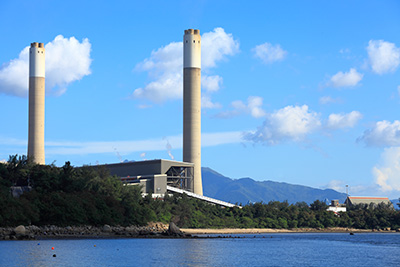 Tests de conformité de routine
Tests de conformité de routine- Test de performance
- RATA (Audits d'essais d'exactitude relative)
- Certification CEM
- Mesures des émissions fugitives
Les applications supplémentaires incluent :
- Tests de conformité de routine
- Test de performance
- RATA (Audits d'essais d'exactitude relative)
- CGA (Cylinder Gas Audits)
- Certification CEM
- Stratification/Cyclonic Flow
- Multi-Sector Air Pollutants Regulations Survey (MSAPR)
- Alternate Biannual Audit
- Mesures des émissions fugitives
Système mobile de surveillance continue des émissions
Our CEMS certification and auditing services include Relative Accuracy Test Audits (RATA) and Cylinder Gas Audits (CGA). RATAs are conducted using a mobile CEMS trailer equipped with pollutant analyzers, sample extractive equipment and data acquisitions systems. Audit results are calculated and reported on-site to ensure a timely response to regulatory compliance requirements. RATAs are typically performed on CEMS parameters NOx, SO2, CO, TRS, and O2.
Notre mobile Système de surveillance continue des émissions (CEMS) est particulièrement bien placé pour fournir des services complets sur site CEMS capacités pour répondre à toutes vos exigences. Le système peut être utilisé pour assurer la conformité réglementaire, le contrôle de la pollution, les évaluations des performances du système et l'optimisation du système. La surveillance de la conformité réglementaire, telle que les RATA ou les enquêtes manuelles sur les piles, est l'application la plus courante.
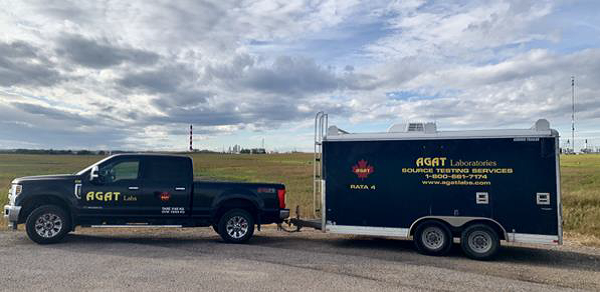
Notre personnel CEMS mobile utilise les techniques de collecte et d'analyse d'échantillons suivantes :
- Chimiluminescence
- Photoluminescence
- Chromatographie en phase gazeuse (PID, FID, TCD)
- Non-Dispersive Infrared (NDIR)Paramagnetic
- Chromatographie ionique
- GC/MS
- SM haute résolution
- Plasma à couplage inductif (ICP)
Méthodes d'essai
Les réglementations de l'industrie dictent les méthodes d'essai à suivre lors de l'échantillonnage et de l'analyse des émissions de polluants.
Les méthodes de test typiques utilisées par notre division de surveillance de la qualité de l'air comprennent les suivantes :
- EPA des États-Unis
- Code d'échantillonnage de la cheminée de l'Alberta (ASSC)
- Méthodes manuelles d'analyse chimique des polluants atmosphériques (MMCAAP)
- Environnement Canada
- Société américaine pour les essais et les matériaux (ASTM)
- Institut national pour la sécurité et la santé au travail (NIOSH)
Codes de pratique
Les règlements proviennent du BC Field Sampling Guide, du AENV CEMS Code, du CCME, des Air Monitoring Directives (AMDs) et des codes de pratiques provinciaux et fédéraux. Ces codes de pratique couvrent :
- Essais d'émissions de turbine CCME
- Essais d'émission d'usine d'asphalte
- Code de pratique des petits incinérateurs
- Test d'efficacité de destruction de l'oxyde d'éthylène
- Code de pratique des centrales électriques au charbon
- Code de pratique pour les installations de séchage du fourrage
Passive Air Quality Monitoring
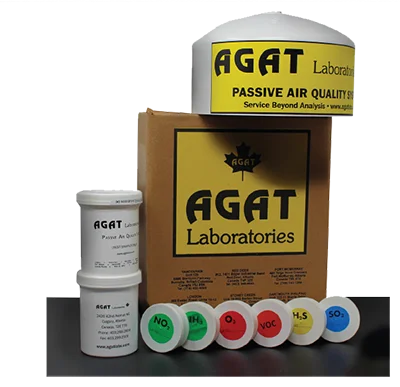 Passive Air Quality Samplers (PAQS) provide a cost-effective method for collecting air quality data over a large geographic area. This system does not require power, data loggers or pumps, making it an excellent tool for sampling in any region, no matter how remote. AGAT Laboratories is accredited under ISO 17025 by the Standards Council of Canada (SCC) and our PAQS have been field-validated to meet the requirements of regulatory air quality monitoring programs.
Passive Air Quality Samplers (PAQS) provide a cost-effective method for collecting air quality data over a large geographic area. This system does not require power, data loggers or pumps, making it an excellent tool for sampling in any region, no matter how remote. AGAT Laboratories is accredited under ISO 17025 by the Standards Council of Canada (SCC) and our PAQS have been field-validated to meet the requirements of regulatory air quality monitoring programs.
The main advantage to this simple but effective sampling device is the ease in which they can be deployed and operated. The PAQS are housed within a protective rain shelter which holds up to 4 samplers, and can be mounted to a post, fence, or other stable structure in the area easily and quickly. The shelter hold the PAQS in a downward position and ensures there is no active movement of air through the sample.
How Does the Sampler Work?
PAQS operate on the principles of adsorption and permeation, physically binding to the specific compounds that are being targeted. Air pollutants will passively diffuse through a semi-permeable membrane and then collect on a filter that has been chemically treated to adsorb those targeted compounds. After being exposed for a specific period of time, the sampler is analyzed in the laboratory to determine the amount of the targeted compound collected.
Pollutants of interest for passive air monitoring include Sulphur Dioxide (SO2), Hydrogen Sulphide (H2S), Nitrogen Dioxide (NO2), Ozone (O3), Ammonia (NH3), and Volatile Organic Compounds (VOCs).
Applications
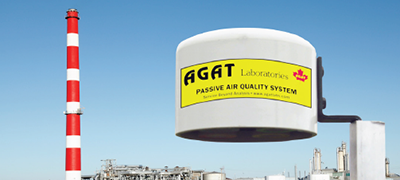
Passive Air Monitoring Samplers are routinely used to meet regulatory air monitoring requirements in Canada, to determine baseline readings prior to facility startup, or as a means to monitor a large geographic area where continuous air monitoring is cost-prohibitive.
Results are used to establish long-term trending of pollutants of interest and can be operated independently from or as part of a larger air monitoring program, which may also include continuous ambient air monitoring.
Continuous Ambient Air Monitoring
Our Ambient Air Monitoring team specializes in providing a full suite of services to clients requiring continuous air quality monitoring, from rental or purchase of custom-built stations, to meteorological monitoring, data acquisition and regulatory compliance reporting (monthly and annual). We work closely with clients to meet the goals of their particular air monitoring project. Our service offerings include:
- Maintenance and calibrations of air monitoring stations that are owned, leased or rented by our clients
- An extensive inventory of spare parts and supplies required to maintain a variety of ambient monitoring instrumentation (eg. Analyzers, meteorological instruments, data acquisition systems)
- On-call staff for emergency response to trouble calls
- Data acquisition and management, QA/QC analysis and government compliance reporting for all Canadian provinces
Applications
- industrial compliance monitoring
- industrial baseline studies
- non-point source testing
- community exposure assessments
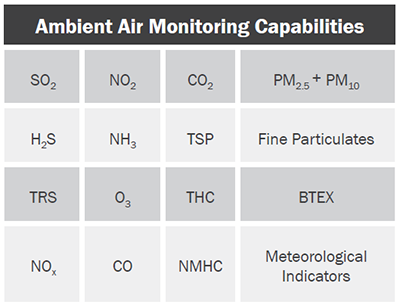
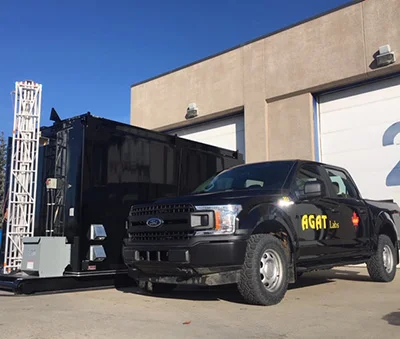
WebAIR
WebAIR is a secure website for accessing real-time (hourly) ambient air monitoring and meteorological data. This secure website is used for ambient air monitoring data applications. Features include printing daily reports of hourly records and trending of daily instrument verifications. Internally we use this powerful tool for daily data validation and site-specific alarms set to trigger immediate notifications for exceedances or indicators of equipment malfunction. With this knowledge we can promptly investigate issues to maximize instrument uptime.
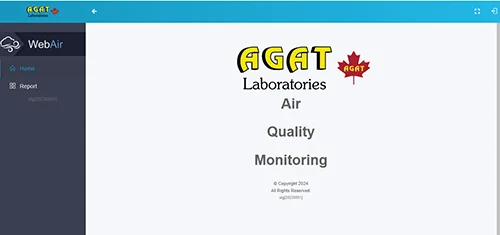
The WebAIR platform functions to serve the end user by providing:
- Cost effective and efficient site communications
- Quick access to data
- Alarming to notify of pollutant exceedances or instrument failures
To access your WebAIR login page please Cliquez ici.
Integrative Air Monitoring
We offer various integrated sampling programs including SUMMA canisters and filter-based collection,drawing air through filters and absorbents for both indoor and outdoor monitoring as well as soil vapor testing.
Applications
- Surveillance de l'environnement
- Odour profiling/complaints
- Industrial hygiene
- Emissions studies
- Landfills
- Site characterization
- Wastewater treatment plants
- Remediation
Échantillonneurs et capacités
We use specialized sampling techniques that align with US EPA methods such as:
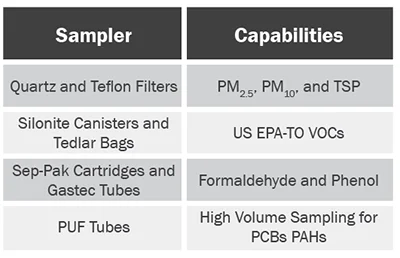
Bidons Summa
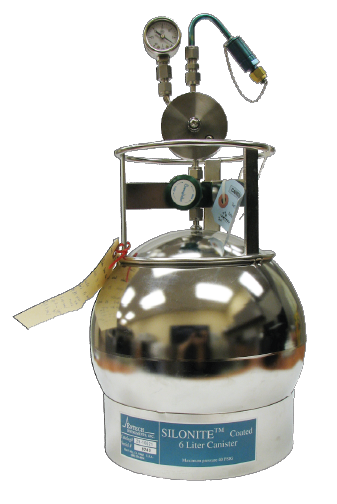
AGAT Laboratories offers Silonite Canisters, the latest in SUMMA testing technology, for the collection of indoor, ambient and stationary air sources and soil vapour. These canisters are used for volatile organic determination in ambient indoor air by EPA TO-14A/15A- Canister Sampling.
La technologie Silonite augmente l'intégrité des échantillons en empêchant la dégradation par l'exposition au soleil et la perméation des COV à travers les parois des vaisseaux. Cela permet une expédition et un stockage faciles sur de plus longues périodes.
Surveillance météorologique
We provide stand-alone meteorological monitoring stations that can be solar-powered, complete with data logging and real-time polling capabilities. Instrumentation measuring wind speed and direction sits atop a 10 meter tower, while lower down additional instrumentation can be mounted for ambient temperature, barometric pressure, etc. Meteorological data is transmitted through the LTE network and polled to our WebAIR data portal for 24/7 accessibility.
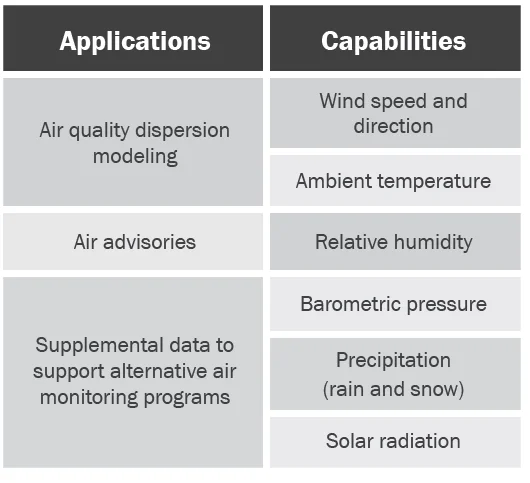
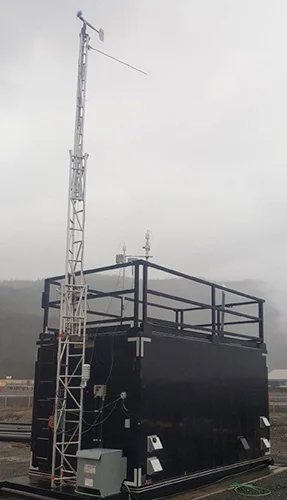
Émissions fugitives
AGAT Laboratories offers Fugitive Emissions field services to assist clients in meeting regulations for emissions monitoring. Our specially-trained and certified technicians.
Using our infra-red GF320 FLIR cameras and QL320 Quantitative Optical Gas Imaging instrumentation, we can assist preventative maintenance efforts and detect leaks in real-time in all manner of pipes and connections, at a wide variety of facilities. Hundreds of components can be scanned in one shift, identifying areas for repair to reduce emissions, increase workplace safety, and improve your bottom line. AGAT Laboratories’ field specialists can record detailed leak information, pictures and videos directly to an online platform, complete with GPS data, helping clients to track and pinpoint leaks immediately and safely. Following identification of the leak, we can accurately quantify the leak rate by loading the video captured by the FLIR camera to the Providence Photonics QL320 Quantitative Optical Gas Imaging device.
